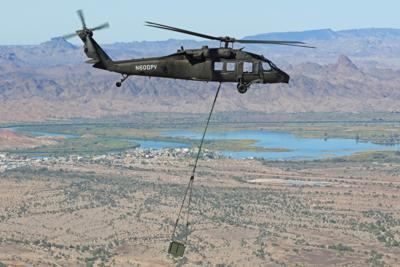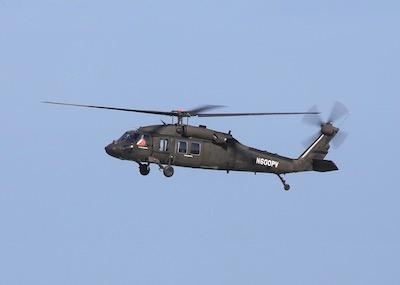A Flight of None...
Lockheed Martin subsidiary Sikorsky and the Defense Advanced Research Projects Agency (DARPA) have secured the attention and interest of the U.S. Army by successfully demonstrating means by which a Black Hawk helicopter can safely and reliably perform rescue operations and internal and external cargo resupply missions—autonomously.

Performed 12, 14, and 18 October as part of the U.S. Army’s Project Convergence 2022 (PC22) experiment, the unmanned Black Hawk flights illustrated how existing and future piloted utility helicopters might soon fly complex missions with reduced crews—if not altogether autonomously. Such capability would afford Army commanders and aviators greater flexibility in planning and executing missions—particularly in limited-visibility or contested environments.
Sikorsky's autonomy system—developed in partnership with DARPA—is known as MATRIX technology, and forms the core of DARPA's ALIAS (Aircrew Labor In-cockpit Automation System) project. ALIAS—for its own part—is a tailorable, extensible, drop-in and removable automation architecture for extant manned aircraft.
Sikorsky director of innovations Igor Cherepinsky states: “We believe MATRIX technology is ready now for transition to the Army as they look to modernize the enduring helicopter fleet, and acquire Future Vertical Lift aircraft. In addition to increasing flight safety and reliability, MATRIX technology enables survivability in high tempo, high threat 21st Century Security environments where Black Hawk helicopters operate today, and DEFIANT X and RAIDER X helicopters could operate in the future. Uncrewed or reduced crewed helicopters could safely perform critical and life-saving missions, day or night, in complex terrain and in contested battlespace."
During the PC22 undertaking, the Sikorsky and DARPA team demonstrated the optionally piloted (read unmanned) Black Hawk helicopter’s ability to execute protracted, high-speed, low-altitude, Nap of the Earth (NOE) flight maneuvers to safely deliver a large quantity of blood product, resupply ground-troops with an external load, and re-route mid-flight to evacuate a casualty.
The flight demonstrations commenced with human pilots flying the Black Hawk to a full-stop landing. While on the ground, the aircrew activated the MATRIX system, thereby transferring control of the aircraft exclusively to the flight-computer. The pilots then disembarked the aircraft which—under the sole auspices of the MATRIX system, completed the following functions:
Long-endurance Medical Resupply: The Black Hawk autonomously flew a five-hundred-pound payload comprising four-hundred-units of real and simulated blood a distance of 72-nautical-miles. Upon reaching a point 34-nautical-miles from it’s departure point, the aircraft descended into a valley where it operated at altitudes as low as two-hundred-feet AGL and speeds up to one-hundred-knots.

Cargo Delivery and Casualty Evacuation (combined mission): Lifting off with a 2,600-pound external load attached to a forty-foot sling, the Black Hawk flew for thirty-minutes at a speed of one-hundred-knots toward a designated landing zone. While in flight, the helicopter was redirected in simulation of a scenario in which a threat near the primary landing site required neutralization.
Sikorsky then demonstrated the manner in which a ground operator possessed of a secure radio and digital tablet may take control of an uncrewed, MATRIX-equipped helicopter, command it to release its sling load, then land at a nearby location for purpose of evacuating a casualty (simulated during the PC22 exercise by a mannequin on a litter). Once the casualty was secured within the Black Hawk, the ground operator launched the aircraft.
During the flight’s return leg, a Battlefield Assisted Trauma Distributed Observation Kit (BATDOK) monitoring device integrated with the helicopter's communications system relayed the patient's vitals—in real-time—to a ground-based medical team.
The PC22 demonstrations were the second series of unmanned Black Hawk flights undertaken this year. Sikorsky and DARPA intend to continue adapting the MATRIX architecture to aircrew support and operations, logistics and medical resupply, casualty evacuation, as well as commercial applications the likes of firefighting, cargo hauling, and urban air mobility.
 Classic Aero-TV: In Praise of Alabamas Patriot Aircraft USA
Classic Aero-TV: In Praise of Alabamas Patriot Aircraft USA NTSB Final Report: Cirrus Design Corp SR22
NTSB Final Report: Cirrus Design Corp SR22 ANN's Daily Aero-Term (12.21.25): Dead Reckoning
ANN's Daily Aero-Term (12.21.25): Dead Reckoning ANN's Daily Aero-Linx (12.21.25)
ANN's Daily Aero-Linx (12.21.25) Aero-News: Quote of the Day (12.21.25)
Aero-News: Quote of the Day (12.21.25)




